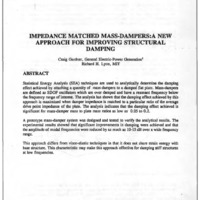Impedance Matched Mass-Dampers: A New Approach For Improving Structural Damping
Item
-
Title
-
Impedance Matched Mass-Dampers: A New Approach For Improving Structural Damping
-
Report Number
-
WL-TR-91-3078 Volume I, p. DAA-1 thru DAA-20
-
Creator
-
Gardner, Craig
-
Lyon, Richard H.
-
Corporate Author
-
General Eletric-Power Generation
-
Massachusetts Institute of Technology
-
Laboratory
-
Wright Laboratory
-
Date
-
1991
-
Date Issued
-
1991-08
-
Extent
-
20
-
Contract
-
Laboratory Research - No Contract
-
DoD Project
-
2401
-
DoD Task
-
240104
-
Identifier
-
ADA241311
-
Format
-
1 online resource
-
Abstract
-
Statistical Energy Analysis (SEA) techniques are used to analytically determine the damping effect achieved by attaching a quantity of mass-dampers to a damped flat plate. Mass-dampers are defined as SDOF oscillators which are over damped and have a resonant frequency below the frequency range of interest. The analysis has shown that the damping effect achieved by this approach is maximized when damper impedance is matched to a particular ratio of the average drive point impedance of the plate. The analysis indicates that the damping effect achieved is significant for mass-damper mass to plate mass ratios as low as 0.05 to 0.2. A prototype mass-damper system was designed and tested to verify the analytical results. The experimental results showed that significant improvements in damping were achieved and that the amplitude of modal frequencies were reduced by as much as 10-15 dB over a wide frequency range. This approach differs from visco-elastic techniques in that it does not share strain energy with base structure. This characteristic may make this approach ·effective for damping stiff structures at low frequencies.
-
Description
-
Statistical Energy Analysis (SEA) techniques are used to analytically determine the damping effect achieved by attaching a quantity of mass-dampers to a damped flat plate. Mass-dampers are defined as SDOF oscillators which are over damped and have a resonant frequency below the frequency range of interest. The analysis has shown that the damping effect achieved by this approach is maximized when damper impedance is matched to a particular ratio of the average drive point impedance of the plate. The analysis indicates that the damping effect achieved is significant for mass-damper mass to plate mass ratios as low as 0.05 to 0.2. A prototype mass-damper system was designed and tested to verify the analytical results. The experimental results showed that significant improvements in damping were achieved and that the amplitude of modal frequencies were reduced by as much as 10-15 dB over a wide frequency range. This approach differs from visco-elastic techniques in that it does not share strain energy with base structure. This characteristic may make this approach ·effective for damping stiff structures at low frequencies.
-
Distribution Classification
-
1
-
Distribution Conflict
-
No
-
DTIC Record Exists
-
No
-
Illinois Tech Related
-
No
-
Photo Quality
-
Not Needed
-
Report Availability
-
Full text available
-
Type
-
article
 article23
article23